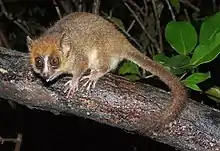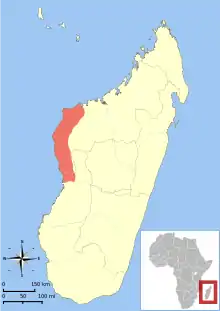Pygmy mouse lemur
The pygmy mouse lemur (Microcebus myoxinus), also known as Peters' mouse lemur or dormouse lemur, is a primate weighing only 43–55 g (1.5–1.9 oz); it is the second smallest of the mouse lemurs.[4] Its dorsal side is a rufous-brown colour, and creamy-white ventrally. It lives in dry deciduous forests.
| Pygmy mouse lemur | |
|---|---|
 | |
| Scientific classification | |
| Kingdom: | Animalia |
| Phylum: | Chordata |
| Class: | Mammalia |
| Order: | Primates |
| Suborder: | Strepsirrhini |
| Family: | Cheirogaleidae |
| Genus: | Microcebus |
| Species: | M. myoxinus |
| Binomial name | |
| Microcebus myoxinus | |
 | |
| Distribution of M. myoxinus[1] | |
The pygmy mouse lemur measures around 12–13 cm (4.7–5.1 in) (head-body length).[4] Its small size and nocturnal nature made it difficult to locate for over a century, and was rediscovered in the Kirindy forest in western Madagascar in 1993. They are believed to inhabit other parts of the island, but so far have only been discovered in a localized area.
The lemur rests during the day, and it has a tendency to sleep in the open, which increases the risk of predation; although this danger is somewhat mitigated by sleeping alone. It can also use the abandoned nests of the Coquerel's giant mouse lemur (Mirza coquereli). During the mating season, sleeping sites of males are distributed over a much broader area than are female sites, indicating that male home ranges are larger than those of females. The home ranges of males overlap during the mating season, and males occasionally roam over long distances during a single night [5]
References
| Wikimedia Commons has media related to: |
| Wikispecies has information related to Pygmy mouse lemur. |
- Baden, A.; Blanco, M.; Chikhi, L. et al. (2014). "Microcebus myoxinus". IUCN Red List of Threatened Species. 2014: e.T13325A16113437. Retrieved 19 July 2020.CS1 maint: uses authors parameter (link)
- "Checklist of CITES Species". CITES. UNEP-WCMC. Retrieved 18 March 2015.
- Groves, C. P. (2005). Wilson, D. E.; Reeder, D. M. (eds.). Mammal Species of the World: A Taxonomic and Geographic Reference (3rd ed.). Baltimore: Johns Hopkins University Press. p. 113. ISBN 0-801-88221-4. OCLC 62265494.
- Mittermeier, R.A.; Konstant, W.R.; Hawkins, F.; Louis, E.E.; et al. (2006). Lemurs of Madagascar. Illustrated by S.D. Nash (2nd ed.). Conservation International. ISBN 1-881173-88-7. OCLC 883321520.
- This information on the sleeping sites and home ranges of male pygmy mouse lemurs in comparison to female pygmy mouse lemurs during the mating season comes from an article titled "A preliminary study of spatial distribution and mating system of pygmy mouse lemurs (Microcebus cf myoxinus)" in the American Journal of Primatology: volume 1, issue 1, pages 41-60.

